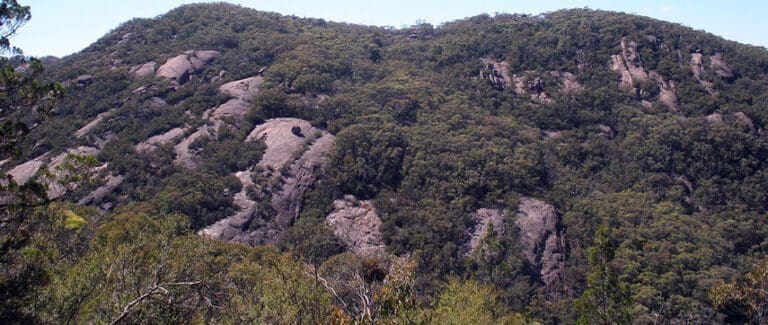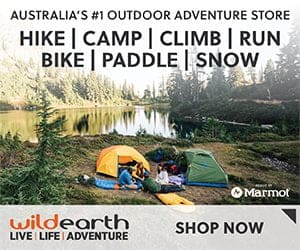Trail Fast Facts
Mt Burrowa and The Pimple is a 16.3km, grade 4 hike in Burrowa-Pine Mountain National Park, Victoria. This hike typically takes 7 hours to complete.
Hike Overview
The Mount Burrowa and The Pimple hike is long and strenuous and the track may be poorly defined in places. From The Ridge carpark the track climbs steeply to The Pimple. This rocky outcrop sits atop sheer rhyolite cliffs and offers excellent views over some of the more remote and rugged areas of the park. The track continues south towards Hinces Saddleon then, turning right, to the summit of Mount Burrowa (1300m) with a number of very steep climbs and descents. It features a variety of vegetation types as altitude and aspect change.
The route, in either direction, is marked with orange arrows on the trees but the tracks are ill-defined and the walks are steep and rough. No water is available along the route so it is necessary to take your own and ensure adequate daylight is available. Snow and strong winds can be encountered in winter so be sure to take warm clothes and a waterproof jacket. The walk takes in many changes in altitude, aspect and vegetation, including peppermint and gum forest, blue gums in the moist gullies, alpine ash on the sheltered southern slopes and snow gum on the ridges.
Return via the same route. If camping overnight, Hinces Saddle, a broad, open area, is a logical campsite.
Camping
Basic visitor facilities are located at Bluff Creek, near the main entrance to the park, and also at Blue Gum Camp, Hinces Creek and Pine Mountain. If camping overnight, Hinces Saddle, a broad, open area, is a logical campsite.
Track Grade
Grade 4 (Hard) - Challenging Walks for Experienced Walkers: Grade 4 on the AWTGS signifies challenging walking tracks. Bushwalking experience is recommended for these tracks, which may be long, rough, and very steep. Directional signage may be limited, requiring a good sense of navigation. These walks are suited for experienced walkers who are comfortable with steeper inclines, rougher terrain, and potentially longer distances.
Tips
The park has limited permanent water sources - carry adequate drinking water when walking.
Walking conditions can be rough and rocky areas slippery when wet - wear sturdy footwear.
Cliffs and rocky bluffs occur within the park - be alert near the edge and look out for falling rocks.
Remote walking tracks may be poorly defined - carry an adequate map and compass or GPS.
Longer walking tracks require a good level of fitness and experience
Overnight hikes
A combination of walking and 4WD tracks may be used to form extended hikes. Popular overnight hikes, which may all be walked in reverse, include:
- Bluff Falls to The Ridge - via Black Mountain and Mount Burrowa (approx. 22 km, 14 hrs)
- Bluff Falls to Hinces Creek - via Black Mountain (approx. 17 km, 10 hrs)
- Hinces Creek to The Ridge - via Mount Burrowa (approx. 19 km, 13 hrs). This route may also be walked as a loop using Cudgewa Bluff Road to return to the start point
- Hinces Saddle, a broad, open area, is a logical campsite for these overnight walks
Map and GPX file
Max elevation: 1279 m
Min elevation: 627 m
Total climbing: 1308 m
Total descent: -1307 m
Trail Location (trailhead)
Sorry, no records were found. Please adjust your search criteria and try again.
Sorry, unable to load the Maps API.
Getting there
The park is located approximately 120 km east of Albury-Wodonga and 25 km northwest of Corryong. It lies between the Murray Valley Highway and the Murray River. Access to many popular visitor areas is from the all-weather Cudgewa Bluff Road, which passes through the park and is a pleasant scenic drive. The turnoff to The Ridge carpark runs off the Cudgewa Bluff Rd.
Photo gallery
If you have any photos from this hike and are happy to share them, please upload your .jpg files here.
Please note: Uploading photos does not transfer ownership of copyright away from you. If requested, you will be credited for any photos you provide and can ask they be deleted at any time.
About the region
The Burrowa-Pine Mountain National Park is a national park in the Hume region of Victoria, Australia. The 18400ha national park is situated approximately northeast of Melbourne and east of Albury-Wodonga. The park stretches between Walwa Creek in the north-west and Cudgewa Creek in the southeast , both tributaries of the Murray River. There you will find Pine Mountain, one of the largest monoliths in the southern hemisphere, which is 1.5 times the size of Uluru. Another peak is Mount Burrowye.
Similar trails nearby
Explore Safe
While planning your hike, it’s important to check official government sources for updated information, temporary closures and trail access requirements. Before hitting the trail, check local weather and bushfire advice for planned burns and bushfire warnings and let someone know before you go. Plan ahead and hike safely.
Let someone know
Adventure with peace of mind: Fill out your trip intentions form. Before you hit the trail, fill out an online form to privately send important details about your hike to your family or friends. If you don’t return on time, they can easily alert emergency services, preventing worry and ensuring a swift response. Hike with peace of mind and enjoy your outdoor adventure to the fullest. Be smart, be safe: Register your plans here.
Gear to consider
What you carry in your pack will depend on the weather, terrain, time of year, type of adventure, and personal preferences. Having trouble deciding what gear’s right for you? My free planning, food and packing checklists provide an introduction to things your could consider (as well as the Ten Essentials) on your day, overnight and multi-day adventures. Customise your kit according to your personal needs, always considering safety first.
Suggest an edit
Trail changed? New features discovered? Has the route changed? Trail permanently closed? Help fellow hikers by suggesting edits! Click above to update route descriptions, GPX file, trail features (like boardwalks), or access conditions (like parking availability). Help me keep the trails info fresh!
Weather
Acknowledgement of Country
Trail Hiking Australia acknowledges the Traditional Owners of the lands on which we hike and pay respects to their Elders, past and present, and we acknowledge the First Nations people of other communities who may be here today.










